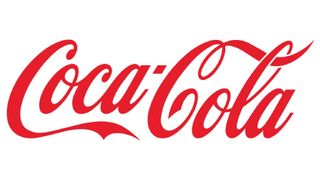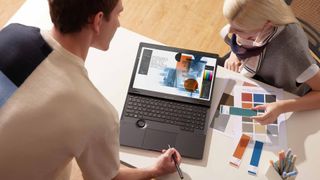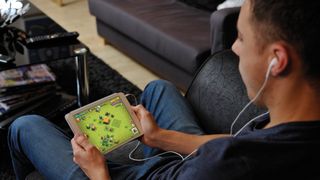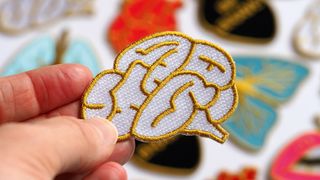Hand made!
Old-school, hand-crafted techniques are challenging today's most advanced digital technology. Illustrator and agent Lawrence Zeegen examines the graphic designer's shift towards using traditional art skills rather than slick computerised processes.
"Computers are worthless. They can only give you answers." This was Pablo Picasso's reflection on the humble computer, albeit uttered long before the digital revolution had even been a sparkle in the eyes of a certain Mr Gates or Mr Jobs. Picasso's death in 1973 ensured that he would play no part in the birth of digital art, but his sentiment is one that captures the current zeitgeist for turning off and tuning out from hours in front of the screen.
For a new generation of designers, illustrators and image-makers there is now a brave new world of old technologies and traditional working methods to be discovered. For the average 20-something student, heading towards graduation from art school, or for those who have already embarked upon their creative career of choice, the beige box of tricks has quite simply been a part of the furniture for much of their lives. In the 21st century, owning and using a computer is the norm - it isn't risky, it isn't sexy, it's just a reality of our times.
Growing up in the 90s ensured this generation had access to a computer from the cradle to the classroom. Staring at a screen became the norm. If you weren't glued to games from Pong to Pac-Man on a PC, battling Sonic on a Sega or getting jiggy with Mario on a Game Boy, you were attempting to create digital images with MacPaint or PixelPaint, exploring the new-fangled World Wide Web or sending a text on your Nokia 3210 - the keyboard and screen reigned supreme. It was really no wonder that the digital had such a stranglehold on image-making - here was the future and in the here-and-now.
But as Picasso had envisaged, the beige box in the corner of the room, now more commonly a flat-screen and in every room, provided only the answers. Crisp digital solutions and a fashion for super-slick-vector-traced-one-size-fits-all-what-you-see-is-what-you-get images has emerged in recent years. In providing more answers than questions, the computer had removed any element of chance. In the crop of recent digital imagery, there has been little room for risk, for failure or, more importantly, for the hand of the artist to shine through - software had taken over. Originality and individualism had become far less important than cool control over a vector curve.
Microwaving mediocrity
It was Milton Glaser - designer of perhaps one of the world's most recognisable logos, I [HEART] NY - who once stated, "Computers are to design as microwaves are to cooking." The man had a point: simply reheating ready-meals rather than cooking with fresh ingredients every time can leave the palette craving new tastes and experiences. Serving up mediocre and mundane dishes day-after-day isn't good for the soul - whereas experimentation is the spice-of-life.
Kerry Roper, who has worked recently on projects for Nike Jordan and Snickers, combines illustration, photography and typography within his images and sees experimentation as the way forward. "I've always enjoyed experimenting with imagery. When something is created by hand I think it becomes more personal, more unique," he says. Roper has always believed in a hands-on attitude. "I first used Deluxe Paint on the Commodore Amiga way back in 1989. It wasn't until around 1994 that I started using a Mac and Photoshop," he admits. "Even then I was always very hands-on, creating collages by experimenting with the photocopier and Omnichrom machines." For those not old enough to remember, Omnichrom was a way of transferring colour from a film sheet to a black-and-white photocopy - very hi-tech at the time, decidedly low-tech nowadays.
Roper is philosophical about the reasons behind a gradual shift back to more hand-crafted working techniques, saying: "The industry tends to be led by visual trends. A little while back there was a glut of vector and computer-generated imagery and it all ended up looking so very similar." Craig Atkinson adds his own thoughts as to why the sea-change has occurred. "I just think that over the last ten years people have realised that the computer is a valuable tool but hands are more valuable," he states. Atkinson, an artist and illustrator with over ten years of exhibiting under his belt, continues his thoughts: "Everything was just so slick for a while - it was all so process-led. I think that it just led straight up a blind alley and as the process itself couldn't change, it was the artist that needed to initiate that change. The only real way out has been a radical move towards the complete opposite - the low-fi."
Get the Creative Bloq Newsletter
Daily design news, reviews, how-tos and more, as picked by the editors.
Digital dangers
Holly Wales, who by her own admission "works non-stop" and despite her website's name doesn't even like Japanese food, combines her working methods. "I think, for me, it was natural to find a hands-on approach to go alongside my digital work, which," she states, "always seemed to be slightly unsatisfying by itself." Despite only graduating in 2005, Wales has already chalked up an impressive client list which includes The Independent newspaper, The Illustrated Ape magazine and the Art Directors Club of Germany.
"My dad is a graphic designer and used to build his own robots and computers, so I grew up alongside them," she states, but her own take on the recent surge in a more crafts-based approach to image-making reflects her sense of humour rather than a genuine considered and rational argument. "The return is probably because staring at a computer screen for too long is bad and leads to dangerous activities such as mail-order brides and blindness." Quite.
Marshall McLuhan, the visionary who coined the phrase 'The Global Village' back in 1967 in his seminal book The Medium is the Massage, once said, in reference to technology, "We become what we behold. We shape our tools and then our tools shape us." Our digital tools in recent years - hardware and software - have become very astute at giving us seemingly never-ending options of drawing and painting tools, a vast array of pens and brushes that in reality take us further away from the real origins of the real instruments. As more designers and illustrators go back-to-basics, the trend for being shaped by our technology, predicted by McLuhan, is a trend that has started to be bucked - many are resisting the pull of technology and are fighting back.
"I always carry a sketch book," states Craig Atkinson. "That's where a lot of my ideas start - I draw a lot, just for myself." Atkinson admits to "fairly basic working methods" and lists his tools of choice: "Pen, pencil, paper and collage - I'll use the computer sometimes just to tidy something up a little, sometimes for trying layers and colours within an image." Atkinson's work, a mix of drawing, painting and collage, is influenced by another mix: ideas and themes. "I like to draw situations and places that I have never been in or to," he offers. "I made a book for a show at the Junc Gallery in LA about what it's like to live in LA - I've never even been there, so it was just based on things that I've heard or imagine about the city." Not the easiest or the most normal of working methods, but one that has snared projects from the likes of The New York Times, Esquire and Orange.
My niece can draw better than you
In the search of originality in image-making, many artists challenge their own drawing techniques by using tools in innovative ways, allowing them to work at evolving new styles and means of expression. Holly Wales, from her studio in East London, explains: "I'm very interested in traditional design considerations like line, composition and balance - they usually play a big part in shaping my images." However, as Wales elaborates, "I like to hold pens in different hands - left hand, right hand, both hands - to get different results. A friend recently bought me a foot-long pencil - it has really freed up my drawing." Despite a growing client base, reactions to her work, such as "My niece can draw better than you" and "Why don't you hire a six-year-old to do it for you?", just make Wales more determined. "Oh, I just see it as a reason to create more work," she states in a matter-of-fact-couldn't-give-a-darn-kind-of-way.
"My grandmother likes my work, so that makes me feel good," admits Andy Rementer. "I do all my drawing and lettering in the old-fashioned way - at the drawing table." Rementer, who was born in New Jersey, educated in Philadelphia, followed a career in NYC working at MTV and Teamheavy, and now lives and works in Italy, admits to a lifelong passion for his work: "I've always been a doodler." Rementer has a certain way with a pencil, and his body of work incorporates a regular weekly cartoon strip - Techno Tuesday, which humorously comments on technology and modern society, published in print and online - as well as projects such as Teach Me, a poster project for Studio Camuffo. "The benefit of doing everything by hand," he explains, "is that one day if all the computers in the world break down, I'd still have something genuine and original to offer the world." Rementer may sound like he's joking, but his dark view of technology and the future is one shared by others.
Paul Burgess, collage artist, illustrator and designer with a 20-year back-catalogue, agrees with Rementer: "The benefit of working in the way I do is that I never get bored and, if my computer goes down, I'm always okay!" Burgess is keen to see a return to a crafts-based approach from a wider perspective. "What is happening," he offers, "goes hand in hand with what's happening in music. There's a big return to loud guitar bands right now. As technology increases in the world so people want to simplify their lives - they don't want to be suffocated by it."
The digit vs the digital
Digital technology may have fallen out of favour recently, but most designers and artists agree it still plays a vital role - it is now the medium that pulls together every hand-crafted discipline and, alongside the scanner and the digital camera, acts as the artist's desktop/canvas/drawing board/darkroom.
"It seems that illustrators have settled down to using the computer as a tool," explains Corinna Radcliffe, herself inspired by Indian art, Victorian decoration, Japanese wood blocks and 1960s poster art. "The computer is no longer an exclusive way of working," she continues, "thus allowing more hand-crafted techniques as a basis to the work now being created." Radcliffe's own work blends both hand-drawn and collaged elements. "I've always initiated images by hand, it allows my personal style to come through," she explains. "The computer enables me to turn often quite simple sketches into more complex compositions and images and allows me to colour them in various ways using gradients and outlines, something which is impossible by hand."
Finding a mix, a method for combining the analogue and the digital while retaining a truly unique personal visual language, is now top of the agenda for those embarking upon a creatively fruitful pathway. "I'm always keen to keep some of the irregularities and my own personal drawing style that comes through when working by hand - the computer just gives me greater options," explains Radcliffe.
"I think," adds Craig Atkinson, "that my self-taught-probably-doing-things-in-a-wrong-way approach to working on the computer helps my work not look too slick, which I like. Also I wouldn't want the digital to overshadow the analogue as far as my working methods are concerned."
Andy Rementer, in Italy, isn't convinced that there is a big bang theory behind the move towards more hands-on, craft-based, analogue work. "Perhaps artists just became bored staring at computer screens all day," he says, "or perhaps it's just another trend!"

Thank you for reading 5 articles this month* Join now for unlimited access
Enjoy your first month for just £1 / $1 / €1
*Read 5 free articles per month without a subscription

Join now for unlimited access
Try first month for just £1 / $1 / €1
The Creative Bloq team is made up of a group of design fans, and has changed and evolved since Creative Bloq began back in 2012. The current website team consists of eight full-time members of staff: Editor Georgia Coggan, Deputy Editor Rosie Hilder, Ecommerce Editor Beren Neale, Senior News Editor Daniel Piper, Editor, Digital Art and 3D Ian Dean, Tech Reviews Editor Erlingur Einarsson and Ecommerce Writer Beth Nicholls and Staff Writer Natalie Fear, as well as a roster of freelancers from around the world. The 3D World and ImagineFX magazine teams also pitch in, ensuring that content from 3D World and ImagineFX is represented on Creative Bloq.




